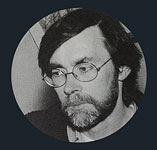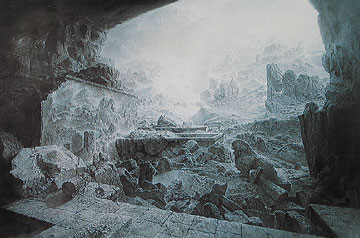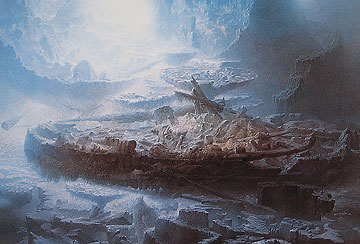|
|

ALAIN
MARGOTTON
|
|
In the 1980's and 90's, Alain Margotton (born 1948 in Argenton sur Creuse) exhibited alongside Di-Maccio, Ruppert, Dietrich and Thomas in Hervé Sérane's Galerie Râ. But, his appearance among these luminaries was not easily accomplished. As Hervé Sérane recalled:
|
"I discovered the works of Alain Margotton in 1983 during a group exhibition in Belfort, some four hundred kilometres east of Paris. It was immediately clear to me that the man was genuine. Without doubt, he lived in an interior world which he timidly attempted to manifest.
"But the drawings at this exhibition were not at all visionary, and suffered from a tendency towards 'illustration'. Still, they bore testimony to a mastery of technique and immense authenticity. I invited him to come and discover the paintings of Gérard Di-Maccio, Klaus Dietrich and Jean-Paul Landais.
"In the span of a few moments, he was terribly moved by all these artists. But his discovery of Di-Maccio's large-format paintings was so overwhelming that he stopped drawing for several months! He felt he was too insignficant...
"I did my best to encourage him, urging him to take up the work once more. And soon after, he brought me a drawing which was absolutely fabulous. I had witnessed the birth of a great Visionary." (65)
After his associations with Sérane ended and Galerie Râ folded, Margotton retired to an old house in Saint Thibaut (l'Aisne) at the extremities of Paris. He now pursues his visions there in undisturbed solitude.
|
|
|
|
|
PARIS - FALL 2004

Alain Margotton
|
These visions include relic-filled tombs, dark caverns with twisting passages or misty landscapes where ships lie in ruin(above left). Rocks, driftwood, and petrified trees are omnipresent. An organic quality may infuse his rock formations, suggesting that these telluric entities once had a life of their own. Yet, all that remains, as some sign of past life, are the negative imprints of fossils encrusted on their surface. Life once dwellt here, but in a past that is far and remote.
The artist himself notes that "I could have been an archaeologist. The objects that I've sculpted suggest an archaeology of the imagination... For as long as I can remember, I have always refused to put in my works any element that could be identified with the present." (66)
Among the few periodicals dedicated to Visionary art in France is Laurent Bramardi's Rose Noire magazine (now defunct). In Bramardi's view, Margotton's work displays "...an endless fascination for Nature itself and its mineral carapace. Man and his clumsy body are rarely present - at best hidden, sometimes, in the rugged pocket of a rocky impasse. These are the traces of a fossilized embryonic life which are found in his drawings, or in the small objects collected here and there which repose today in his studio, placed among his own sculptures." (67)
Margotton's working methods are unique insofar as he will load his canvases with multiple layers of paint, moving progressively into uttermost blackness. But then, in white or lightly-coloured crayon he will highlight, adding silhouettes and gently suggesting touches of light that glow luminously in the darkness.
Quite recently (May 2004), Margotton had an exhibion on rue Mazarine in Paris which demonstrated a continuing fascination with these methods and themes. But, his work has now evolved to include human figures, often cast into sharp chiarascuro through their dark and deeply-textured environments. The lone figure may be an aboriginal hunter or a more haunting image of a crouching woman gauzed and veiled. The latest works, though a remarkable advance, remain true to his earlier vision.
|
|
|
|


